INTRODUCTION
Medicines are vital in in treating and managing diseases and improving health. However, any medication, especially if misused, could result in potential risks and adverse effects.
When a medicine is granted authorization, safety information on the product may be relatively limited and not all potential risks or adverse reactions have been identified. This results from several factors in clinical trial development, including limited diversity in populations regarding comorbidities and concomitant medications. Because of this, there are some risks that will only be discovered and characterized in the post-authorization phase.
Risk management aims to address safety uncertainties in the product life cycle and to plan appropriate actions.
RISK MANAGEMENT PROCESS
A standardized approach to risk management involves the following continuous activities:
Fig. Risk management cycle, European Medicines Agency and Heads of Medicines Agencies
Risk management is an essential part of pharmacovigilance since it provides a structured benefit-risk assessment framework, ensuring that the benefits of a medicine outweigh the risks throughout its lifecycle, from detection and assessment of safety concerns to implementation (such as product labeling and educational materials) and evaluation of risk minimization strategies.
At Unilab, pharmacovigilance is a key aspect in ensuring every medicine and vitamin produced bears Unilab Quality Alaga. This means every Unilab product goes through all four marks of Quality Alaga—subok at napatunayan, ayon sa standards, sinuring mabuti, and gawang world-class. Products are rigorously studied and thoroughly checked in every step of the life cycle, including after a consumer has purchased it. The thrust towards ensuring patient safety even beyond the authorization phase is a demonstration of our commitment to delivering Unilab Quality Alaga, where we strive to go above and beyond so that every Filipino receives the quality care they need.
ROLE OF PHARMACISTS
As important healthcare providers, pharmacists work collaboratively with other healthcare professionals in various patient care settings, weighing the potential risks against the desired benefit of each medication and taking specific actions that contribute to improving patient safety.
This collaboration among healthcare professionals and other organizations within the healthcare industry is vital in ensuring patients receive the quality care they need to achieve better health outcomes and live fuller lives.
References:
-
Pharmacists’ Impact on Patient Safety. American Pharmacists Association.
-
Guideline on good pharmacovigilance practices. European Medicines Agency and Heads of Medicines Agencies, 2012.


